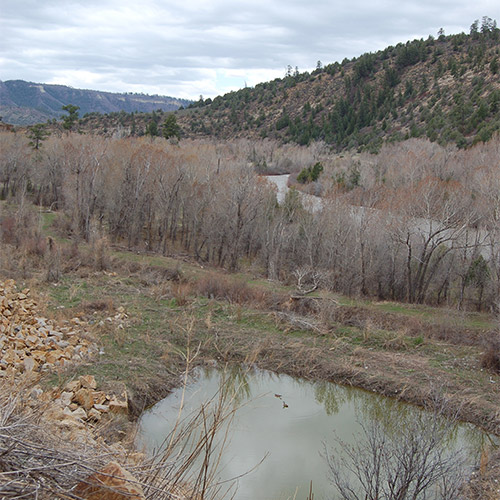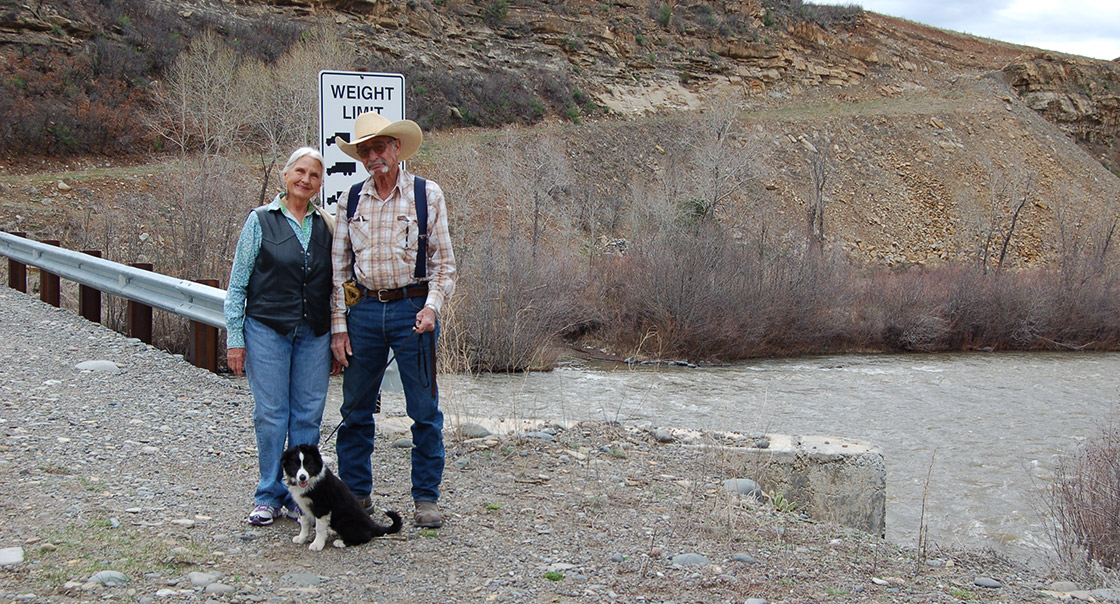Photo: Lee and Jac Constant, beside their new bridge across the San Juan River. The bridge has created access to a deposit of “superior” gravel.
As the five of us — Jac and Lee Constant and their new puppy, plus my two-year-old granddaughter Simone and myself — began our 40-minute hike to the top of the mesa where a gravel pit operation might soon be located, I asked Jac and Lee to pose next to their new bridge across the San Juan River, finally connecting the two halves of the Constants’ 320-acre homestead.
The property is located about 12 miles south of downtown Pagosa Springs, down Trujillo Road near the once-thriving community of Trujillo. The bridge was constructed three years ago — a gift to Jac and Lee from their son, a retired engineer.
In the photo, you may be able to make out the rough gravel road that heads up the rocky hillside on the opposite side of the river. This is presumably the route that trucks will take someday, to access a large gravel deposit on the Constants’ property.
Jac and Lee had invited me to visit them, and see the gravel pit location — the subject of a pending (and controversial) gravel mining application submitted to the Archuleta County Planning Department by C&J Gravel of Durango. I’d first heard about the mining application at a Pagosa Springs Town Council meeting, when Town Planning Director James Dickhoff had mentioned his concerns that large — and heavy — gravel trucks might be using the town streets to make gravel deliveries to the northern and eastern parts of the county.
The Town government is not directly involved in the application process, because the proposed pit is located in the unincorporated county. I’m not clear exactly how the Town would propose to limit truck traffic on public roads, but I imagine they could come up with something.
A few days ago, one of our Daily Post readers had sent me the following short email:
The Two Rivers gravel source is located approximately 12 1/2 miles down CR 500 aka theTrujillo Road. It is positioned on top of the mesa abutting the southeast side of the junction of the Rio Blanco and San Juan Rivers. The gravel pit access road meets the Trujillo Road at roughly the 12500 mark.
The site has a large deposit of superior gravel.
I think that some are concerned that gravel trucks might travel across Cascade Blvd to Buttress and out through various streets of Pagosa Meadows. Some will probably go through South Pagosa via 8th street.
Some of the gravel will surely go south on CR 500 to the lower Trujillo Road and Cat Creek road and possibly the Arboles and Allison area.
Archuleta County is presently hauling some of its gravel from Durango.
Trujillo Road, also known as County Road 500, begins at the southern edge of downtown Pagosa and heads out into some of the more scenic parts of Archuleta County — vast, open meadows dotted with mature Ponderosa pines and very little in the way of human habitation. About seven miles of the road pass through a 6,300-acre conservation easement on the Alpine Cascade Ranch, owned by the Bass family. Simone and I passed a small herd of elk and another small herd of deer — and a small herd of long-horn cattle — but only a couple of mailboxes.
The excellent scenery was not matched by the condition of the road. In spite of keeping my speed down to about 30 miles an hour, I found myself wondering if I would need my alignment checked by the time I got back to town.
The road draws gradually closer to the San Juan River, and the valley becomes more narrow and rocky. The green meadows and Ponderosa pines are replaced by sagebrush and Pinon pines, giving a definite sense that we were approaching the New Mexico border.
About 12 miles down the road, the San Juan River is joined by the Blanco River, and we are at the site of the proposed Two Rivers Gravel Pit.

Our hike had begun at the Constants’ modest modular home, and we walked at a slow pace, due to Simone’s two-year-old stride and Jac’s healing leg; he’d broken his femur this past winter. Lee provided a steady and lively narration during the walk, peppered with Pagosa history. Both Lee and Jac grew up in Pagosa Springs; they married as teenagers and purchased the Trujillo Road property back in the mid-1950s — and then, in a classic case of deferred gratification, made payments on the property for 30 years before finally erecting their modest house near the river.
Lee Constant: “It used to be wonderful fishing here in the summer, when they used to stock [the river]. It isn’t now, but when they stocked it, it was wonderful fishing. We had signs on our fence — the one fence that we had, because we didn’t have all these fences back then, because we couldn’t afford them until we got the money to build them — and those signs said, ‘Fishermen welcome, respect your privilege.’
“Mostly, they did respect their privilege.”
A few did not, and Lee and Jac found themselves cleaning up trash at the end of each summer, when they took an annual week-long vacation on their property.
“We never bitched to anybody. You look in the old newspapers; you won’t find any letters to the editor from us, complaining about the trash. There was no outcry from us. That’s why I feel so hurt now, because — my God — why are the people complaining about a gravel pit, on our property? They’re treating us like we don’t deserve to benefit from what is rightfully ours.”
I told Lee that I didn’t think the letters of complaint sent to the newspaper, or to the County Planning Department, were aimed at the gravel pit, per se — and I didn’t belive they weren’t personal attacks. The complaints are aimed at the trucks.
The people of Archuleta County navigate 300 miles of gravel roads every day, and regularly complain whenever the roads suffer from a lack of gravel. But no one wants to see trucks plying the road in front of their own house, delivering the actual gravel that they cherish — due to the dust and noise generated by a gravel truck.
At the top of the mesa, Lee stood beside a test hole dug by C&J Gravel.
“I don’t know anything about gravel,” she said, “but they tell me this is a glacial deposit — and it holds up better, on roads, than river gravel. Lasts longer.”

According to Jac, no one knows exactly how much glacial gravel this site holds. I was told that the proposal from C&J Gravel owner John Gilleland is to operate the pit maybe two months of the year, maybe three, in 30-day increments. The pit could conceivably provide gravel for Archuleta County roads for many years — even decades — into the future.

